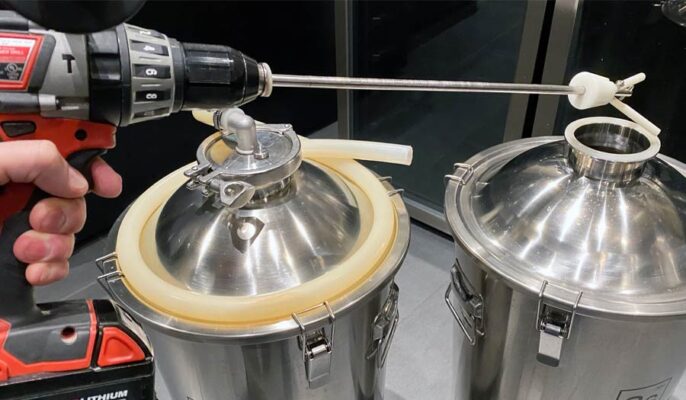Oxygen plays a special role throughout the beer-making process. Must to ensure adequate growth of yeast cells during the lag and exponential phases of fermentation. Many people choose the simple method of aerating by stirring. If you want to introduce oxygen into wort that has been cooled. Mixing oxygen with hot or warm wort inhibits bacterial growth and increases the likelihood of an infected beer. You should always ensure that the wort is cooled to pitch temperature immediately after boiling is complete and before aeration.
Why do yeast need oxygen?
At every stage of the post-fermentation beer brewing process, oxygen is enemy number one. Because it destroys the beer’s appearance, aroma, and most , its flavor in a process called oxidation.
When the wort is boiled during brewing, it removes many unwanted compounds, making the wort sanitary and ready for the yeast to do their thing, but it also removes most of the oxygen from the wort.
How much oxygen is needed?
Most textbooks will recommend a standard dissolved oxygen rate of 8-10ppm (mg/L) at medium gravity. 5ppm is considered a least. 8ppm can be achieved using regular atmospheric air, but levels above this will must the use of pure oxygen. The key here is to understand that we are talking about dissolved oxygen and the rate at which oxygen dissolves in the wort depends on many factors including the temperature of the wort, the specific gravity of the wort, and the size of the air bubbles.
Many factors determine how much oxygen yeast needs. Examples include the type of yeast strain, the amount of yeast inoculated, the starting gravity of the wort, and the amount of dregs in the wort. The ability of the wort to absorb oxygen depends on factors such as gravity (sugar content) and temperature. The higher the specific gravity or temperature of the wort, the less oxygen it can absorb.

How to introduce oxygen into the wort ?
There are many ways to introduce wort, the two main ones being aeration and oxygenation. Aeration is the process of adding air to a solution while oxygenation is the process of adding pure oxygen to a solution. The difference between the two is that there is only about 20% oxygen in the air. The composition is different, using pure oxygen is the faster method. Both of these methods are used after the wort is boiled and cooled to the fermentation temperature.
Aeration method
Ways to get aeration more for home brewing:
- Stir the wort with a masher paddle, whisk, or other utensil
- Using the paint stirring attachment on the drill
- Cover and shake the fermenter or jar
- Pour the wort between two fermenters or large bottles
- Splash effect when transferring to fermenter using a mesh filter
Due to the addition of air containing approximately 21% oxygen, it may take 15-20 minutes to introduce the required oxygen into the wort. These methods make it difficult to know how much air or oxygen is added to the wort.
Oxygenation method
More effective and efficient than aeration, which involves adding pure oxygen to the wort, some other specialized equipment is required. Common oxygenation methods are:
- Diffusion stone submerged in wort
- On-line oxygenation, injecting oxygen into the wort when it goes from the kettle to the fermenter
Since you’re using pure oxygen, the process is faster, more efficient than aeration, and less risky since it’s less likely that any microbes or other organisms can survive in a pure oxygen environment.
What happens when there is not enough oxygen?
Oxygen in the wort results in a higher germination rate and, so, higher cell growth and more efficient fermentability. During fermentation without the addition of more oxygen, the yeast never reach the cell mass obtained in aerobic fermentation, resulting in long lag times,Sometimes, the desired terminal gravity is not achieved.
The long-term effects of reduced oxygen levels on yeast polymorphism are also important if the yeast is re-inoculated. When the yeast lacks enough oxygen early on, it causes the cells to become weaker later on. This results in cells with reduced glycogen reserves and membranes that can withstand the stress of fermentation and the alcoholic, low pH environment of beer.
Helps Brew Better Beer
Oxidation of the boiled wort after cooling is essential for proper fermentation by brewing yeast. To be successful, homebrewers must pay attention to this important step in the brewing process, selecting and implementing successful wort oxygenation techniques that fit their equipment and budget. Oxygen is essential for the growth of brewer’s yeast.




